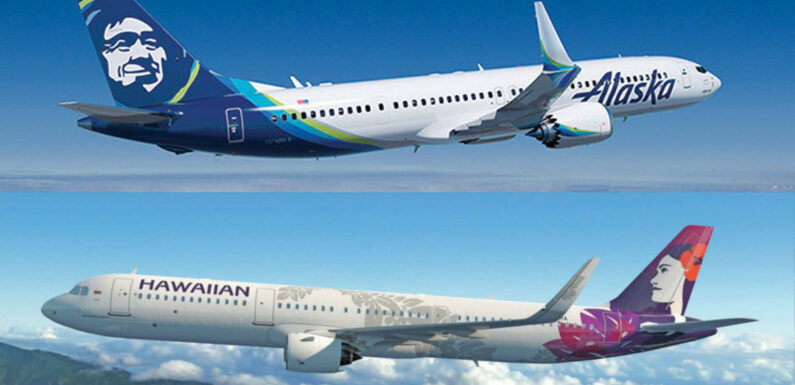
Analysts say the planned acquisition of Hawaiian Airlines by Alaska Airlines would be a boon to both carriers.
What’s unclear is how regulators at the consolidation-averse Justice Department will greet this latest merger attempt among U.S. airlines.
Under the deal announced Dec. 3, Alaska would purchase Hawaiian for $1.9 billion, inclusive of $900 million in debt.
Alaska plans to keep the Hawaiian Airlines brand distinct, a nod to the brand’s power in the Islands, while otherwise running the two carriers as a merged airline, with centralized scheduling, a single loyalty program and interchangeable aircraft.
Under the merger, Hawaiian would join Alaska in the Oneworld alliance. Critically for Hawaii residents, Alaska has pledged to maintain a robust interisland schedule, noting that it has its own experience with an intra-Alaska network that includes service to 16 destinations that aren’t reachable by road.
Alaska said it expects to realize $235 million in annual cost synergies from the merger and estimates percentage earnings growth in the upper single digits after two years.
Helane Becker, an investment analyst for Cowen Group, said the merger is a lifeline for Hawaiian Airlines, which has continued to bleed money in the post-Covid era due to factors largely beyond its control, including the Maui wildfires in August, weak tourism demand from Japan and new competition from Southwest.
In the third quarter, Hawaiian suffered a net loss of $48.7 million. Becker said Hawaiian is potentially on a trajectory to run out of cash next year. With the merger, she said, “they don’t have to file for Chapter 11 and restructure their balance sheet.”
Instead, said Becker, Hawaiian can adjust to maintain liquidity during the year to 18 months that the two airlines expect it will take to close their deal.
She added that Hawaiian and its shareholders should also be pleased with the purchase price of $18 per share. The company’s shares closed at less than $5 on the Friday before the deal was announced.
Becker and others see the proposed merger as win for Alaska, as well. With a purchase of Hawaiian and its 61 aircraft, Alaska would gain substantial scale much more easily than it could through organic growth. Especially of note is that the purchase would give Alaska its first widebody aircraft and turn the airline into a transpacific operator.
Brett Snyder, who pens the Cranky Flier blog and owns the Cranky Concierge travel agency, said that with those Hawaiian Airbus A330 and Boeing 787 widebodies, Alaska could launch long-haul operations from its Seattle hub to strategic Oneworld markets, including Tokyo, Sydney and London. Such routes would provide a compelling sales point to corporate travelers as Alaska competes in Seattle with the airport’s other hub carrier, Delta.
The addition of widebodies would also give Alaska the opportunity to offer lie-flat seats on transcontinental routes.
Analysts also agree with the contention of executives at Hawaiian and Alaska that Alaska is the ideal operator to continue the crucial Hawaiian interisland network, due to its experience serving remote Alaska destinations. They also back the management teams’ assertions that the merger would facilitate easier movement by Hawaiian customers to continental U.S. destinations beyond the West Coast via the Alaska network and Alaska’s codeshare partnership with American.
How will DOJ react?
A wild card, however, is how the Justice Department will view the proposed merger. The Biden administration DOJ has already successfully broken up American and JetBlue’s Northeast Alliance in the New York and Boston markets.
And closing arguments in the trial over the DOJ’s effort to prevent a merger of JetBlue and Spirit wrapped up on Dec. 5.
In a Dec. 3 update for investors, analyst Michael Linenberg of Deutsche Bank estimated that the transaction has an 80% chance of being completed. His bullishness is due to the fact that of the 324 routes Alaska flies and the 51 flown by Hawaiian, the two carriers compete directly in just 12 markets. Among those, there are only three routes in which Alaska and Hawaiian are the lone carriers.
But Christine Bartholomew, a professor of law and an antitrust expert at the University at Buffalo, said the merger proposal does raise antitrust concerns.
An Alaska acquisition of Hawaiian would give the Seattle-based carrier a 39.4% seat share in the Hawaii-U.S. mainland market, leapfrogging it well ahead of current leader United, which has a 23.8% seat share, Cirium flight schedule data shows.
In addition, Bartholomew said, the 10 routes on which Hawaiian and Alaska are either the lone carriers or comprise two out of the three carriers will be of interest to regulators.
She predicted that the DOJ will push for concessions from the carriers in order to remedy impacts on competition.
“I can’t say they’ll be able to reach an agreement,” Bartholomew said, adding that it will depend on how willing Alaska and Hawaiian are to tailor the merger in response to regulator concerns.
“This will be an interesting one,” she said.
Source: Read Full Article









